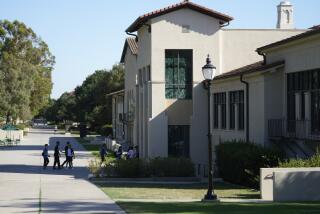Occidental Chief Swiftly Paints a Bold New Image : Management: Determined to trim unwanted assets and reduce massive debt, Armand Hammer’s successor, Ray Irani, gets down to the art of running a business.
- Share via
A painting by the old master Rubens no longer hangs in the chairman’s office at Occidental Petroleum Corp., the office from which company patriarch and art connoisseur Armand Hammer once presided over a far-flung empire.
In its place hangs a $1,000 oil of an Alpine meadow--a painting so undistinguished that Hammer’s successor, Ray R. Irani, can’t even remember where he got it.
Hammer “would be shocked,” Irani conceded last week in an interview at Occidental’s Westwood headquarters.
But Irani doesn’t seem to mind. Hammer’s artworks have been moved next door, to the new museum that bears his name, and Irani finds his own painting soothing and serviceable. He freely admits that, unlike Hammer, his interests lie elsewhere.
The change in artwork is one of many signs that Occidental Petroleum under Irani is undergoing a transformation that would have been unthinkable under Hammer, who died in December at age 92 after running Occidental for more than 30 years.
Irani, who was anointed by Hammer to fill his shoes, wasted no time in formulating a bold restructuring plan, announced last month, to redress many of the problems at the diversified energy and chemical company.
Though Irani refuses to criticize Hammer’s management even after his death, many analysts and investors say the problems resulted from bad decisions by the strong-willed, charismatic “Doctor”--and that Irani is just the man to fix them.
Wall Street analysts applaud both Irani’s credentials and his restructuring plan, but they reserve opinion on whether he can pull it off. They especially question whether Occidental can generate enough cash to meet its ambitious debt-reduction goals simply by selling off unwanted assets, considering the economy is in recession and that the assets include such unpopular items as Libyan oil fields and a deep-pit coal mine in China.
“I have to take a wait-and-see attitude to see whether the company can do what it says it can do,” said Frederick P. Leuffer Jr., an analyst with C. J. Lawrence, Morgan Grenfell Inc. in New York, whose comments reflected those of many other analysts.
For his part, Irani is confident that Occidental can reach its goals, without offering any details. “We think we have a good program, and it’s going to be successful,” Irani said simply. “Time will tell.”
Analysts agree that the changes at the company are directly attributable to the differences in management style between Hammer and Irani.
Hammer was the visionary entrepreneur in love with the deal and a man who spent as much time collecting art and organizing disaster relief as he spent tweaking the company’s balance sheets.
Irani, by contrast, is viewed as the consummate professional manager--a man with little interest in getting his name on museum walls, but an executive with a firm grasp of the details in running the nation’s sixth-largest energy company in terms of 1990 sales.
In that, Irani is the right man at the right time, analysts said. “Irani is an example of the kind of management needed in the second or third generations, when a company is too large to be run as a private fiefdom or a hobby any longer,” said Bernard J. Picchi, an analyst with Salomon Bros. in New York.
“What’s coming to fore now is a realistic, professional managerial approach,” added Eugene L. Nowak, an oil analyst with Dean Witter in New York.
Irani refuses to discuss such distinctions between himself and the man who was his mentor from the time he came to Occidental from Olin Corp. in 1983. Instead, Irani attributes the restructuring plan to changes in the economy.
“The 1980s were a period when credit and money were readily available,” he said. “We perceive at least the early 1990s . . . (as) a period when people are going to consolidate and watch their balance sheets, and I think it’s in that spirit that we did the restructuring.”
Still, the centerpiece of Irani’s plan is to reduce Occidental’s massive debt of $8.5 billion by $3 billion in the next two years mainly by selling off non-strategic assets--including many businesses that Hammer entered into almost as a whim. Those include film production, Arabian horse breeding and hotel management in Africa.
Irani’s plan also slashes the longstanding dividend and focuses the company on its core operations in oil, gas and chemicals. Last week, the company announced layoffs of more than 1,000 employees to save $100 million in costs. In addition to cutting debt, the plan is intended to boost earnings by $200 million a year, raise cash flow by $600 million and bolster the stock, which has languished below $20 a share until recently.
As part of the plan, the company took a massive, $2.046-billion charge against fourth-quarter earnings, reflecting restructuring costs and write-offs of unprofitable ventures. With the charge, the company reported a net loss of $1.695 billion in 1990, compared with net income of $285 million the year before.
Almost as a symbol of what Irani called “the New Oxy,” the first announced sale was of Occidental’s 5.4% stake in Church & Dwight, the New Jersey manufacturer of Arm & Hammer baking soda.
The stake was acquired in 1986, and “there was little reason to do so except vanity,” wrote Steve Weinberg in his unauthorized biography, “Armand Hammer: The Untold Story.”
“Not all the lucrative sidelines in the world could erase Hammer’s frustration at having to answer ‘no’ when asked if he were the baking soda king. . . . In 1986, Hammer succeeded in obtaining a piece of the business so he could answer ‘yes,’ more or less honestly.”
At the time, the Wall Street Journal headlined its story about the acquisition: “Armand Hammer and Arm and Hammer Finally Arm in Arm.”
In addition to divesting itself of a vanity purchase, the sale of the Church & Dwight stake signaled Irani’s intention not to unload any assets at “fire sale” prices: The company realized a $4-million gain on the $19-million sale of 1.1 million Church & Dwight shares.
The only major asset that Irani has identified specifically for sale is Occidental’s 51% share of IBP Inc., one of the nation’s largest meatpackers--a divestiture long counseled by analysts and investors.
“We didn’t see how it fit in with their corporate strategy,” said Dale M. Hanson, chief executive officer of the California Public Employees’ Retirement System, which owns 2.3 million shares.
Hammer ignored such entreaties, and while Hammer was alive, Irani was compelled to turn down several offers for the Nebraska-based company.
The reason? Though the low-margin business is unrelated to Occidental’s other operations, its revenues enabled Occidental to be ranked among the top industrial companies in the nation--fulfilling another desire of Hammer’s, analysts said.
Now, however, Irani apparently feels free to dump IBP. Again, he confirms that there are several suitors--but it’s unclear how soon a sale might come.
Analysts estimate the meat processor could bring in $500 million to $600 million but argue that likely domestic suitors such as ConAgra Inc. or Cargill Inc. would run afoul of antitrust laws. Others, such as the large food processors, might be dissuaded because IBP’s slim profit margin would dilute their earnings, they said.
The best prospects are probably foreign investors, especially the Japanese, who are eager for a foothold in the domestic beef industry.
Other than IBP, Irani is playing his cards close to his vest and declines to specify which assets the company will sell. He wants to preserve the company’s flexibility, doesn’t want to signal his intentions to potential buyers and wants to reserve the option not to sell something if he can’t find a good price, he said.
“Everything is easy to sell if you want to leave money on the table,” he said. “We take the approach that we want a fair price for the assets that we want to sell, or that people ask us to sell.”
But to meet its debt-cutting goal, analysts question whether the company can avoid selling at least some of its crown jewels. Those are its oil and gas properties, including its North Sea holdings; its MidCon Corp. gas pipeline company, and its chemical operations, which have provided the bulk of Occidental’s operating earnings in recent years. Sale of MidCon alone could bring in enough cash to meet the $3-billion goal, analysts said.
“He has not identified any assets for sale, other than IBP,” Leuffer said. “He’s indicated he’s not willing to sell MidCon at this time, and other than that . . . you have to scratch your head and say, ‘What assets can be sold and raise $3 billion?’ ”
Added Thomas Samuelson, an energy analyst with Duff & Phelps in Chicago: “Selling assets can prove to be a little tricky in the current environment.”
One likely candidate for sale: Occidental’s interest in its Canadian oil and gas unit, which analysts estimate could also bring in $500 million to $600 million.
But Irani said he is willing to bide his time for now. For one thing, the company recently refinanced its debt load and has no compelling need to sell anything. Its 1991 debt repayment is $30 million; its 1992 repayment is $485 million.
“Both of these totally can be done just because we cut the (annual) dividend (from $2.50 a share to $1),” Irani said. “We can repay the debt without selling anything whatsoever and still have excess cash flow. . . . We don’t have a gun to our heads to sell assets.”
So far, Irani’s plan is earning praise from analysts and investors. In the weeks after the plan was announced, Irani said he received a couple hundred letters from the small investors who make up a disproportionate percentage of Occidental’s shareholders. More than half were irate at the dividend cut, but others supported the plan, he said.
Irani has also apparently won fans on Occidental’s 17-member board of directors, eight of whom are Hammer contemporaries in their 70s or 80s. The board was long perceived as a “rubber stamp” for Hammer’s whims.
“Dr. Hammer cast a very big shadow on that organization, and I think to me the one thing that has been very impressive . . . is that Ray Irani sold the board on this” so quickly, said Hanson at the state retirement system. “A lot of sacred cows were slaughtered, and for Irani to have turned the company around as far as its emphasis in a very short period was very impressive.”
More to Read
The biggest entertainment stories
Get our big stories about Hollywood, film, television, music, arts, culture and more right in your inbox as soon as they publish.
You may occasionally receive promotional content from the Los Angeles Times.









